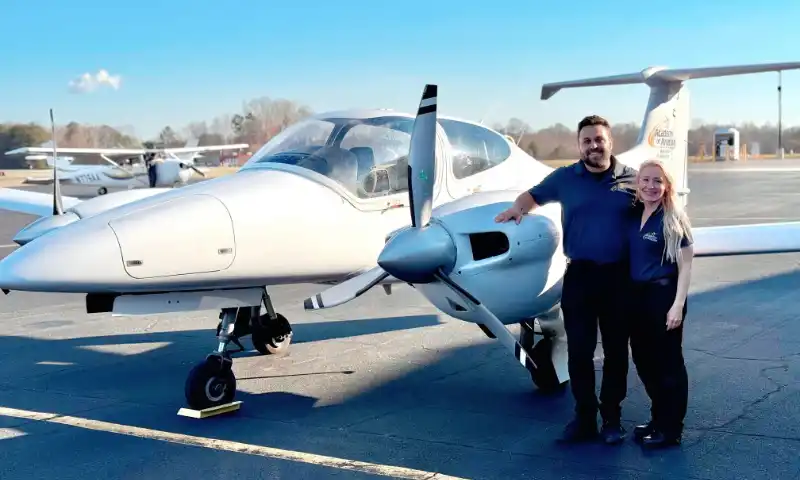The Best is always Subjective
What is a Good Flight School?
"A good flight school prepares you to pass the FAA exams in the time frame you
desire, for the price quoted, safely."
Of course there are certainly some variations to the answer, but any answers that are not
similar to the quote above are at best incomplete, and at worst, demonstrating a
misunderstanding of flight training. How is a potential student to know if a school lives up
to the definition of "good?" How would a new student realize that "Flight Schools" are not
created equal?
Let's start by breaking down the biggest piece of the puzzle. Why is a "school" recognized as good?
In the world of flight schools, there are only two flavors. Part 141 and Part
61, referred to by the section of the Aviation regulations that dictate their
operations.
Part 141 schools are closely monitored by the FAA. The administrators,
instructors, aircraft, simulators, and study materials must all be approved. If a school is
approved, and
that's a big "if", the FAA continually audits operations, safety, and student performance. A
school that does not demonstrate student success will be stripped of their Air Agency
Certificate. Essentially, a 141 approved flight school has a seal of approval from the FAA.
The FAA makes a list of all certified flight schools available on their website.
A Part 61 flight school is a myth. Searching the FAA site for a "Part 61
flight school" will return no results because the FAA does not consider them to be schools
at all.
There is no required structure, curriculum, equipment, support staff, or student performance
metrics to
assess. Any flight instructor with access to an aircraft may call themselves a "Part 61"
flight school.
A good flight school "prepares you to pass the FAA exams."
The critical idea to take away here is that a school shares the responsibility for student
success by maintaining the focus on the students' goals. Students are more successful when a
school proactively follows a well organized curriculum, tracks student progress,
communicates performance and develops strategies to overcome setbacks.
Simply repeating lessons over and over with a flight instructor rarely leads to success. If
a Part 61 flight instructor isn't intently focused on your goals, you have to ask yourself
whose goals they are focused on.
A good flight school trains you "in the timeframe you desire."
An actual goal requires a time frame or a due date; otherwise it's just a dream. Dreams are
great to have, and we want you to achieve your dream, but we don’t think a school has the
right to charge you for a dream without a substantive process.
A good school will help set reasonable expectations and take the lead in keeping those
expectations on track. A good school starts with a clearly defined syllabus that works as
your road map, provides sufficient resources to support your goals, and maintains an
administrative staff
that keeps the student body organized so instructors can focus on their students.
A good flight school trains you "at the price quoted"
This is likely the single most
misunderstood part of
deciphering if a
school is "good".
Of course students look at pricing. Flight training is expensive and the internet is filled
with stories of students being taken advantage of. However, hourly costs are only half of
the
equation; the other half being how many hours will you need to reach your goals. Flight
training breaks down to hourly rates in nearly all programs. The more hours you need to pass
your check ride, the more it will cost you to achieve your goals.
If a student were to look just at price, a school that flies for $200 an hour is more
appealing than one that flies for $250 an hour. However, that only equates to an additional
10 hours of training required by the part 61 instructor before he is more expensive than a
141 Flight School. Looking back at all the other information provided above, the question a
student should ask is which option will get me to my goals more
efficiently.
As stated above, students are more successful when a school proactively follows a well
organized curriculum, tracks student progress, communicates performance and develops
strategies to overcome setbacks. Working with a school that shares your goals greatly
reduces the hours of training required.
Furthermore, 141 schools are allowed to graduate students at lower minimum hours because the
FAA is confident in the school. A student flying in a part 61 environment would be required
to fly at least 40 hours to get their Private Pilot License, while a 141 school is allowed
to
graduate you at 35 hours. While getting your certificate at the minimums is rare, 141
schools graduating students in less time is not. Also common is the higher pass rate for
both the written exams and the check rides for 141 graduates.
A good flight school focuses on "safety."
You do not have to be an airplane mechanic to know that flying a plane built in the 70’s is likely to have more mechanical issues than a new or late model aircraft. Aircraft flown for part 141 schools must be maintained to exacting standards and are inspected by the FAA as part of their 141 auditing processes.
